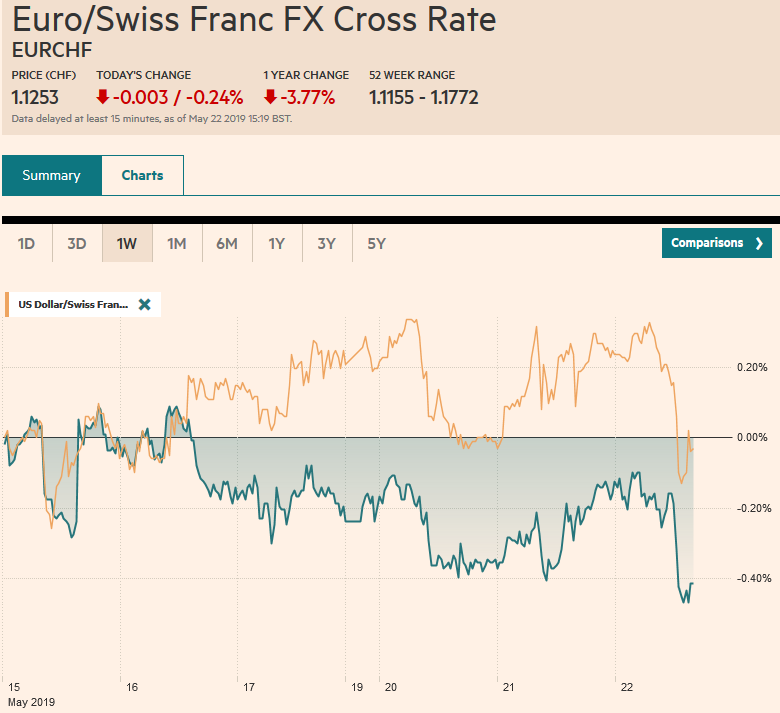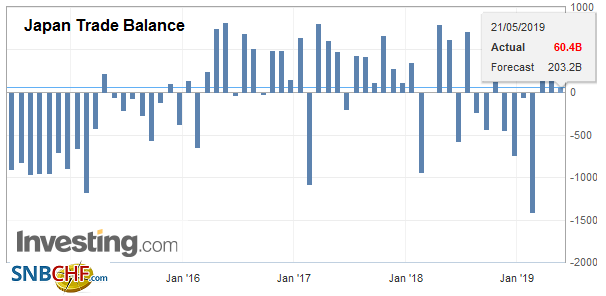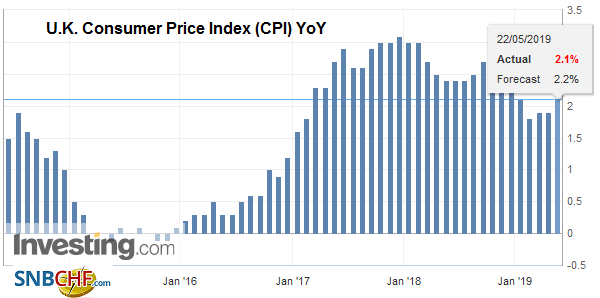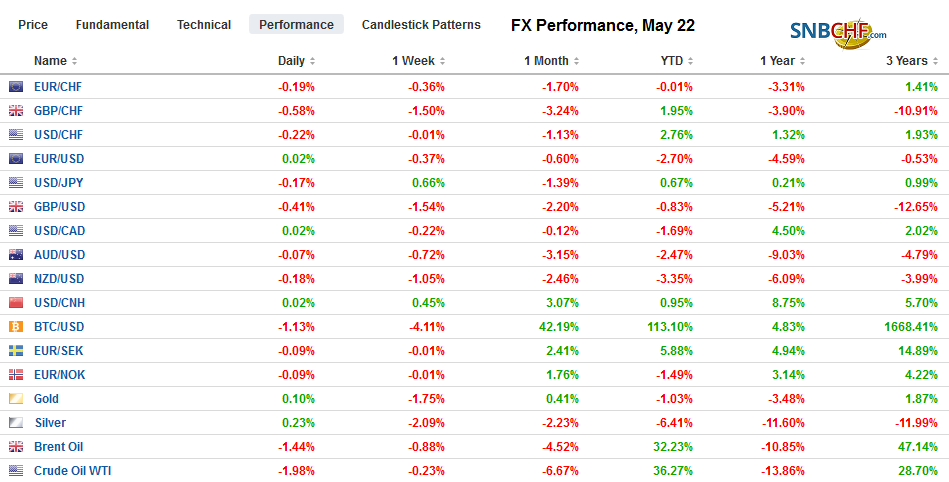Swiss Franc The Euro has fallen by 0.24% at 1.1253 EUR/CHF and USD/CHF, May 22(see more posts on EUR/CHF, USD/CHF, ) Source: markets.ft.com - Click to enlarge FX Rates Overview: There is a nervous calm in the capital markets. Yesterday’s rally in US shares failed to excite global investors. China, Hong Kong, and Taiwan markets fell, while Japan was mixed. Foreign investors continued to sell Korean shares, but the Kospi rose. European shares narrowly mixed, leaving the Dow Jones Stoxx 600 little changed. There are two notable exceptions to the slightly softer 10-year benchmark yields. The first is the couple basis point increase in China (to a little above 3.3%). The other is the four basis point decline in UK
Topics:
Marc Chandler considers the following as important: 4) FX Trends, Brexit, China, Featured, FOMC, Japan Trade Balance, newsletter, trade, USD
This could be interesting, too:
Nachrichten Ticker - www.finanzen.ch writes Die Performance der Kryptowährungen in KW 9: Das hat sich bei Bitcoin, Ether & Co. getan
Nachrichten Ticker - www.finanzen.ch writes Wer verbirgt sich hinter der Ethereum-Technologie?
Martin Hartmann writes Eine Analyse nach den Lehren von Milton Friedman
Marc Chandler writes March 2025 Monthly
Swiss FrancThe Euro has fallen by 0.24% at 1.1253 |
EUR/CHF and USD/CHF, May 22(see more posts on EUR/CHF, USD/CHF, ) Source: markets.ft.com - Click to enlarge |
FX RatesOverview: There is a nervous calm in the capital markets. Yesterday’s rally in US shares failed to excite global investors. China, Hong Kong, and Taiwan markets fell, while Japan was mixed. Foreign investors continued to sell Korean shares, but the Kospi rose. European shares narrowly mixed, leaving the Dow Jones Stoxx 600 little changed. There are two notable exceptions to the slightly softer 10-year benchmark yields. The first is the couple basis point increase in China (to a little above 3.3%). The other is the four basis point decline in UK Gilt yield to a little below 1.04%. The yield was off amid the concerns about consequences of a no-deal Brexit, which increased after Prime Minister’s botched attempt to revive her Withdrawal Bill, even before the slightly lower than expected CPI print. Sterling has been driven to new four-month lows against the dollar and is extending its losing streak against the euro into the 13th consecutive session. The euro is pushing through GBP0.8800 for the first time since the ill-fated attempt in February. Outside of sterling, the other major currencies enjoy a firmer bias today. Among emerging market currencies, the South Korean won firmed slightly after officials stepped up their warning that the recent decline has been excessive, implicitly threating intervention. The Chinese yuan was flat and has not fallen this week. The dollar finished last week just below CNY6.9180 and is holding a little above CNY6.90 this week. |
FX Performance, May 22 |
Asia PacificChinese state media appears to become more forceful anti-American. The Huawei ban is widely understood as an escalation of hostilities. Although security issues are at stake, both the ZTE case and now Huawei is intricately related to trade as well. There is some thought that Trump would lift the ban if it ensured a comprehensive trade agreement. Meanwhile, reports suggest that the US is considering banning as many as five Chinese firms that provide surveillance products (e.g., Hikvision and Dahua). At the same time, China reiterated its willingness to address the bilateral trade imbalance by buying more US products and services. This has been a Chinese offer since the US backed out of the trade agreement struck by Treasury Secretary Mnuchin a year ago. Between the trade tensions between the US and China, the slowing of the Chinese economy, and widespread weakness in semiconductors and autos continues to take a toll on the region. Yesterday’s news of a steep 11.7% decline in exports in the first 20 days of May, followed news of a decline in Singapore’s non-oil exports and has been echoed today by the fifth consecutive decline in Japanese exports. Exports fell 2.4% year-over-year in April, the same pace as March. The Bloomberg survey had found a median expectation for a 1.6% fall. Of note, exports to China fell 6.3%, and more than a 40% decline in equipment for making semiconductors. Exports to the US rose 9.6%, which may be fodder for Trump when he meets Prime Minister Abe this weekend. Imports rose 6.5% compared with expectations for a 4.5% gain. The gain in imports is viewed as an indication of more robust domestic demand. Japan’s trade balance a quarter of the size forecast and near JPY60.5 bln is the smallest April trade surplus in four years. That said, Japan’s current account surplus is driven by income from overseas investment (interest, dividends, profits, licensing fees, royalties, etc.). Separately, Japan reported a stronger than expected rise in March core machine orders (3.8%). |
Japan Trade Balance, April 2019(see more posts on Japan Trade Balance, ) Source: investing.com - Click to enlarge |
So far, this is the first session in five that the dollar has not risen above the previous day’s high against the yen. However, for the seventh session, it recording higher lows. The dollar is confined to roughly the middle third of a yen on the JPY110-handle. The dollar looks sandwiched between two option expirations today JPY110.50 (~$545 mln) and JPY110.80 (~$560 mln). The Australian dollar is consolidating in a narrow 20-pip range above $0.6870. The intraday technicals leave the Aussie vulnerable in the North American session. Against the Chinese yuan, the dollar remains within the range set last Friday (roughly CNY6.8900- CNY6.9180). Among emerging market currencies, we noted South Korean officials have stepped up their verbal intervention to support the won. The weakest currency in the region today is the Indonesian rupiah where protesters clashed with government forces over the April election outcome. The rupiah fell for the third consecutive session and seven of the past eight.
Europe
The nearly immediate rejection of Prime Minister May’s last attempt to find a compromise formula shocked many observers. Sterling initially rallied on headlines of her movement but sold off even harder when it became clearer that there was really little new and it was not enough to appease either Labor or Tory backbenchers. The expected strong showing of Farage’s Brexit Party in this week’s EU Parliament elections will likely excite those Conservatives seen favoring a quick even if painful exit, as May’s successor.
United KingdomThe UK’s economic data is lost in the focus on Brexit and on gaming how will be the next resident of 10 Downing Street. April CPI rose but not as much as expected. CPIH for from 1.8% to 2.0%, just missing the median forecast (Bloomberg survey) of 2.1%. The pattern held for the other measures as well, and the core rate was unchanged at 1.8%. The same is true for producer prices. |
U.K. Consumer Price Index (CPI) YoY, April 2019(see more posts on U.K. Consumer Price Index, ) Source: investing.com - Click to enlarge |
The euro has been confined to an almost 25-tick range through the European morning (~$1.1150-$1.1175) after posting an outside day yesterday. Yesterday’s high was a function of the rally in sterling, and the single currency approached $1.1190. It has not been above $1.12 since last Thursday. The proximity of a 1.5 bln euro option at $1.1180 and the penchant for North America to sell into euro upticks warns of downside risks. Sterling’s slide continues. Near $1.2660, it is at its lowest level since January 4. Congestion around $1.26 from the second half of last December may offer nearby support. There is a roughly GBP325 mln option struck at $1.2665 that expire today and may slow the decline.
America
The minutes from the FOMC meeting earlier this week will be scrutinized for clues into how long officials will be patient and how close are they to cutting rates. We expected the minutes to show that their rhetoric is serious and sincere. After being surprised by the strength of Q1 GDP, officials can look past what appears to be a soft Q2 pace (less than 2%). However, even the dovish contingent, like Bullard, is content with the status quo. He may be the first Fed official to say that the central bank may have slightly overdone it with the December hike. He begs the question. Is the US economy so sensitive and our metrics so precise that a 25 bp move one way or the other is really a make it or break it event?
Canada reports March retail sales figures today. A 1.2% gain is expected after February’s 0.8% advance. Economists had forecast a 0.4% increase in February. The Bank of Canada meets next week and is widely anticipated to remain on hold (overnight rate is at 1.75%). The smallest US premium over Canada for two-year money since November and more stable equities is pushing the US dollar below the CAD1.34-CAD1.35 range. This month’s lows were in the CAD1.3375-CAD1.3380 range. The lower Bollinger Band (two standard deviations below the 20-day moving average) is near CAD1.3390. Be careful playing for the breakout. At the same time, the market is pushing the dollar to MXN19.00. Below there, support is seen near MXN18.90. The intraday technicals are getting stretched.
Graphs and additional information on Swiss Franc by the snbchf team.
Tags: #USD,Brexit,China,Featured,FOMC,Japan Trade Balance,newsletter,Trade

